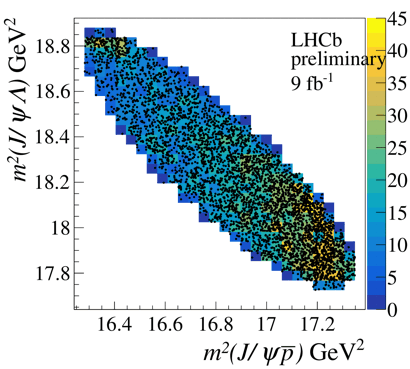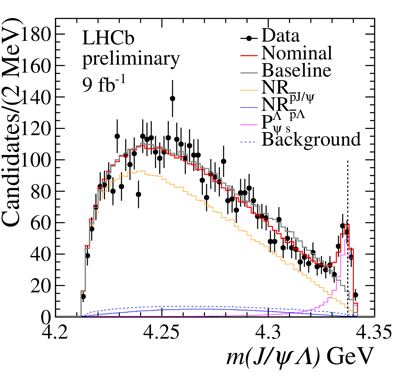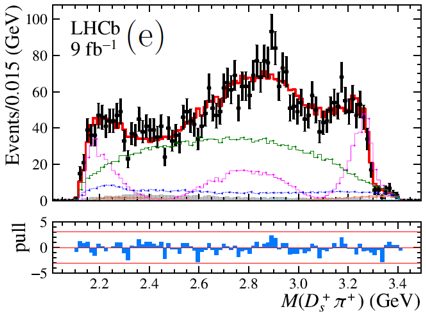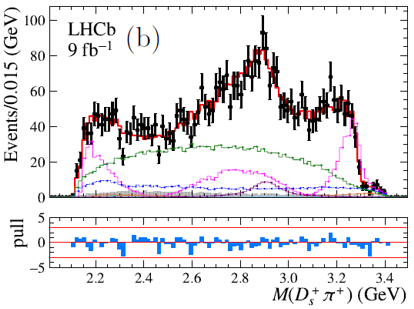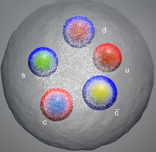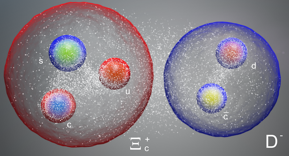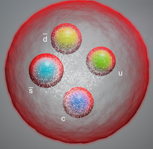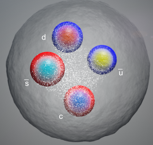Today, at the CERN seminar, the LHCb Collaboration reported the observation of a strange pentaquark, a doubly charged tetraquark and its neutral partner. These results will also be presented at the ICHEP 2022 International Conference on High Energy Physics in Bologna, Italy, starting tomorrow.
The pentaquark, PΛψs(4338)0, is observed with high significance in the J/ψΛ mass in the B–→J/ψΛp decays. This is the first observation of a strange pentaquark with a minimum quark content ccuds. The decays were studied with the help of a so-called Dalitz plot, invented in order to study particle decays into three particles. The axes of the plot are the squares of the invariant masses of two pairs of the decay products. The presence of intermediate particles — formed for a tiny fraction of a second during the B– particle decay — is revealed through vertical or horizontal bands in what would otherwise be a uniformly-populated plot. The orientation of the band indicates the pair of particles to which the intermediate “resonance” decays. The PΛψs(4338)0 pentaquark is observed as an accumulation of events in the upper left corner of the Dalitz plot seen in the image above to the left. It is therefore also visible in the J/ψΛ mass projection on the vertical axis seen in the image above to the right as a Gaussian-like accumulation of events at the highest mass region. The mass and the width of the new pentaquark is measured to be 4338.2±0.7±0.4 MeV and 7.0±1.2±1.3 MeV, respectively. The preferred quantum numbers are JP=1/2–.
The two tetraquarks, Tacs0(2900)++ and Tacs0(2900)0, are observed in joint analysis of the B0→ D0Ds+π– and B+→D–Ds+π+ decays. The new tetraquarks are observed with masses around 2.9 GeV in both the Ds+π+ and Ds+π– mass spectra. The former corresponds to the first observation of a doubly charged open-charm tetraquark with minimal quark content csud and the latter is a neutral tetraquark composed of csud quarks. The Ds+π+ and Ds+π– mass spectra in the top images above indicate that the sum of contributions from conventional resonances (particles) cannot explain experimental distribution around the mass of 2.9 GeV. On the other hand, the experimental distributions are well understood when the contributions of the two new teraquarks are included in the analysis as shown in the two bottom images above. The mass and the width are determined to be 2.908±0.011±0.02 GeV and 0.136±0.023±0.011 GeV, respectively. The quantum numbers are determined to be JP=0+. In the language of particle physics the two tetraquarks are isospin partners.
In the conventional quark model, strongly interacting particles known as hadrons are formed either from quark-antiquark pairs (mesons) or three quarks (baryons). Particles which cannot be classified within this scheme are referred to as exotic hadrons. In their fundamental 1964 papers [1] and [2], in which they proposed the quark model, Murray Gell-Mann and George Zweig mentioned the possibility of adding a quark-antiquark pair to a minimal meson or baryon quark configuration. It took 50 years, however, for physicists to obtain unambiguous experimental evidence of the existence of these exotic hadrons. In April 2014 the LHCb collaboration published measurements that demonstrated that the Z(4430)– particle, first observed by the Belle collaboration, is composed of four quarks (ccdu). Then, a major turning point in exotic baryon spectroscopy was achieved at the Large Hadron Collider in July 2015 when, from an analysis of Run 1 data, the LHCb collaboration reported significant pentaquark structures in the J/ψp mass distribution in Λb0→ J/ψpK– decays. Since then many other exotic hadrons have been observed by LHCb as reported at this web page.
Various interpretations of these structures have been proposed, including tightly bound pentaquark or tetraquark states as well as loosely bound molecular baryon-meson or meson-meson states. These two possibilities are illustrated in the image to the left for the case of pentaquark PΛψs(4338)0. The color of the central part of each quark is related to the strong interaction color charge, while the external part shows its electric charge. The leftmost artist’s image illustrates how the quarks could be tightly bound; to form this pentaquark. The mass of this pentaquark coincides with the threshold for Ξc+D– baryon-meson production which may favour a loosely bound baryon-meson molecule interpretation, seen in the image to the right, in which a meson and a baryon are connected by a residual strong force similar to the one that binds protons and neutrons together within nuclei.
The two artist’s images to the left represent the two tetraquarks reported today shown in the tightly bound form, the left one the doubly charged tetraquark Tacs0(2900)++ and the right one its neutral partner Tacs0(2900)0.
The names of the pentaquark and tetraquarks reported today follow a recently established new naming convention.
On the ten-year anniversary of the Higgs discovery this result reminds us of the diversity and importance of results produced by the LHC experiments. For example, already 66 hadrons have been discovered at the LHC, of which 59 by LHCb. We can look forward to many more discoveries in Run 3.
Read more in the seminar presentation and in the forthcoming papers.

